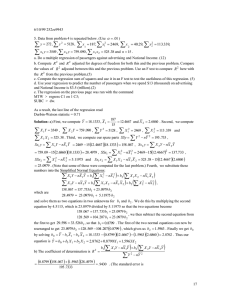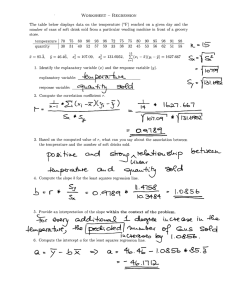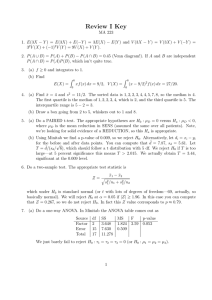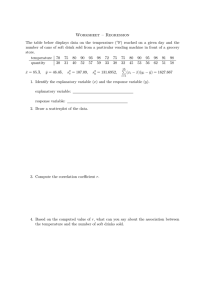6/4/99 252z9943
advertisement
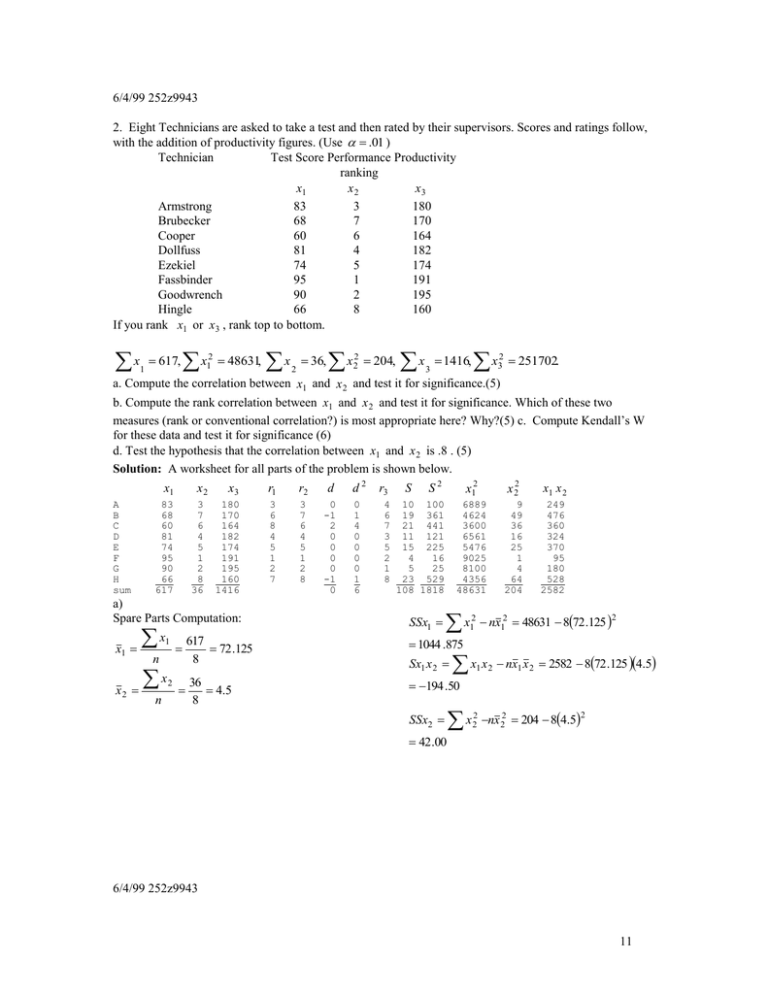
6/4/99 252z9943 2. Eight Technicians are asked to take a test and then rated by their supervisors. Scores and ratings follow, with the addition of productivity figures. (Use .01 ) Technician Test Score Performance Productivity ranking x1 x2 x3 Armstrong 83 3 180 Brubecker 68 7 170 Cooper 60 6 164 Dollfuss 81 4 182 Ezekiel 74 5 174 Fassbinder 95 1 191 Goodwrench 90 2 195 Hingle 66 8 160 If you rank x1 or x3 , rank top to bottom. x 1 617, x 2 1 48631, x 2 36, x 2 2 204, x 3 1416, x 2 3 251702. a. Compute the correlation between x1 and x 2 and test it for significance.(5) b. Compute the rank correlation between x1 and x 2 and test it for significance. Which of these two measures (rank or conventional correlation?) is most appropriate here? Why?(5) c. Compute Kendall’s W for these data and test it for significance (6) d. Test the hypothesis that the correlation between x1 and x 2 is .8 . (5) Solution: A worksheet for all parts of the problem is shown below. x1 A B C D E F G H sum x2 83 68 60 81 74 95 90 66 617 3 7 6 4 5 1 2 8 36 x3 r1 r2 d d2 180 170 164 182 174 191 195 160 1416 3 6 8 4 5 1 2 7 3 7 6 4 5 1 2 8 0 -1 2 0 0 0 0 -1 0 0 1 4 0 0 0 0 1 6 a) Spare Parts Computation: x1 x2 x 1 n x n 2 617 72 .125 8 36 4.5 8 r3 4 6 7 3 5 2 1 8 S S2 10 100 19 361 21 441 11 121 15 225 4 16 5 25 23 529 108 1818 SSx1 x12 x 22 x1 x 2 6889 4624 3600 6561 5476 9025 8100 4356 48631 9 49 36 16 25 1 4 64 204 249 476 360 324 370 95 180 528 2582 x nx12 48631 872 .125 2 2 1 1044 .875 Sx1 x 2 x x 1 2 nx1 x 2 2582 872 .125 4.5 194 .50 SSx2 x 2 2 nx 22 204 84.52 42 .00 6/4/99 252z9943 11 The simple sample correlation coefficient is r XY nXY X nX Y 2 XY nXY , so using x X nX Y nY 2 2 nY 2 2 R 2 2 2 194 .50 1044 .875 42 .00 2 2 2 in place of y , we get r square root of 194 .50 2 1044 .875 42 .00 .9285 . From the outline, if we want to test H 0 : xy 0 against H1 : xy 0 and x and y are normally distributed, we use t n 2 r 1 r n2 .9285 1 .9285 82 2 6 3.707 , 6.15 . Since t .005 2 we reject H 0 . b) Remember that you were advised to rank x1 and x3 top to bottom. This is not the usual way of doing things, but makes sense in this case since x 2 already has the best as 1. Remember that d r1 r2 ,and then rs 1 d 1 66 0.9285 . If we want a 2-sided test at the 99% confidence level of nn 1 88 1 2 6 2 2 H 0 : 0 , compare rs with the 0.5% value from the Pearson’s rank correlation coefficient table. Since the table value is .7450, reject the null hypothesis. We conclude that the rank correlation is significant. c) Following the process in the outline, compute S SR n 1c 108 SR 13 .5 . From this Kendall’s W 2 n SR 1818 813.52 360 , where S 8 n 3 n 360 .9523 . If H 0 is 8 disagreement, S can be checked against a table for this test. But n is too large for the table, so use S 2n 1 k n 1W 37 .9523 20 . This has the 2 distribution with n 1 7 degrees of 1 knn 1 12 2 1 k2 12 1 32 12 8 3 freedom. Since .2017 18.4753 is below our 2 , reject H 0 . d) I don’t believe that anyone did this section. The outline says “ We need to use Fisher's z-transformation. 1 1 0 1 1 r and a standard deviation of Let ~ z ln . This has an approximate mean of z ln 2 1 0 2 1 r ~ n 2 z z 1 , so that t .“ sz sz n3 12 6/10/99 252z9943 3. Samples of demand for four types of sailboat sold by your firm are as follows: West Coast East Coast Total Pirates Revenge 74 146 220 Jolly Roger 54 110 164 Bluebeard’s Treasure 46 100 146 Ahab’s Quest 50 120 170 Total 224 476 700 Do all tests at the 95% confidence level. a. Management had initially assumed that the proportion of total sales of “Pirates Revenge” would be at most 30% of sales. Test this. (3) b. Test the hypothesis that sales of the “Pirates Revenge” are the same proportion of sales on both the East and West Coast (4) c. Test the hypothesis that sales on the West Coast follow a uniform distribution (i.e. that each model is the same proportion of West Coast sales) (5) d. Test the hypothesis that the proportions of each boat sold are the same on both coasts. (5) Solution: a) Table 3 says the following: Interval for Confidence Hypotheses Test Ratio Critical Value Interval pcv p0 z 2 p Proportion p p0 H 0 : p p0 p p z 2 s p z p H1 : p p0 p0 q0 pq p sp n n p 1 p H 0 : p .30 If we check the original data, total sales of “Pirates Revenge” were 220 Out of 700, or H 1 : p .30 p p 0 .3143 .30 .0143 .8256 . We reject p .3143. Thus, if we use the test ratio method z p .30 .70 .01732 H 0 if it is greater than z .05 700 1.645 . It is not so we do not reject H 0 . b) From Table 3 again: Interval for Confidence Interval p p z 2 sp Difference between p p1 p 2 proportions p1q1 p2 q 2 q 1 p sp n1 n2 Hypotheses Test Ratio H 0 : p p 0 z H 1 : p p 0 p 0 p 01 p 02 or p 0 0 p p 0 p If p 0 p p01q 01 p02 q 02 n1 n2 Or use Critical Value pcv p0 z 2 p If p0 0 p p0 p0 q 0 1 n1 1 n2 n1 p1 n2 p2 n1 n2 s p H 0 : p 0 H 0 : p1 p 2 Our Hypotheses are or where p p1 p2 . If we use the test ratio method, we H 1 : p 0 H 1 : p1 p 2 220 146 74 .3143 , p1 .3067 . So p p1 p 2 .3304 and p 2 need to find p 0 700 476 224 3304 .3067 .0237 . 6/10/99 252z9943 13 p 0 q 0 1 1 .3143 .6857 1 1 . n2 224 476 .00141 .036145 n1 p p 0 .0237 z 6.2815 . Since z .025 1.960 do not reject H 0 . p .036145 p c) H 0 : Uniform . So Since O sums to 224 and there are 4 models, divide 224 by 4 to get 56. The actual comparison can be done by either summing E O 2 E O E E O E O2 74 54 46 50 224 56 56 56 56 224 -18 2 10 6 0 324 4 100 36 E O2 or by summing E O 2 E 5.78571 0.07143 1.78571 0.64286 8.28571 O2 and subtracting n . E O2 E 97.7857 52.0714 37.7857 44.6429 232.2857 O2 n 232 .2857 224 8.2857 . Since there are 4 items in E E the comparison and we have used the data to estimate 1 parameter df 4 1 3 and .2053 7.8147 , we So 2 8.28571 or 2 reject H 0 . The Kolmogorov-Smirnov method could also be used for this problem. d) H 0 : Homogeneity . The proportions in rows, p r , are used with column totals to get the items in E . Note that row sums in E are the same as in O . O sum pr E sum pr 74 146 220 .3142857 70 .40 149 .60 220 .3142857 54 46 110 100 164 146 .2342857 .2085714 52 .48 46 .72 111 .52 99 .28 164 146 .2342857 .2085714 50 120 sum 224 576 170 700 .2428571 1.000000 54 .40 115 .60 170 sum 224 .00 576 .00 700 .2428571 1.000000 The actual comparison can be done by either summing So 2 E O O E 74 54 46 50 146 110 100 120 700 70.40 52.48 46.72 54.40 149.60 111.52 99.28 115.60 700.00 E O2 E do not reject H 0 . -3.60000 -1.52000 0.72000 4.40000 3.60001 1.52000 -0.72000 -4.40000 0.00000 0.87513 or 2 E O2 12.9600 2.3104 0.5184 19.3600 12.9600 2.3104 0.5184 19.3600 E O 2 E or by summing E O 2 E 0.184091 0.044024 0.011096 0.355883 0.086631 0.020717 0.005222 0.167474 0.87513 DF r 1c 1 31 3 O2 and subtracting n . E O2 E 77.784 55.564 45.291 45.956 142.487 108.501 100.725 124.567 700.875 O2 n 700 .875 700 0.875 . Since .2053 7.8147 , we E 14 6/10/99 252z9943 4. Data on passengers (in thousands), advertising (in $thousands) and (National income in $trillions) appears below. (Use .05 ) x 3 y (2) (This must be done correctly pass adv inc season a) Compute y 15 17 13 23 x1 10 12 8 17 x2 2.40 2.72 2.08 3.68 x3 1 1 1 1 to get full credit for b.) b) Compute a simple regression of passengers against National income. (6) c) Compute R 2 (4) d) Compute s e (3) 16 10 2.56 1 e) Compute s b2 ( the std deviation of the coefficient 21 14 20 26 18 17 18 23 15 16 y 272 , 15 3.36 0 10 2.24 0 14 3.20 0 19 3.84 0 10 2.72 0 11 2.07 0 13 2.33 0 16 2.98 0 10 1.94 1 12 2.17 1 2 y 5128 , x 187, x y 3549 , x 1 2y 1 759 .090 , of National Income) and do a confidence interval for 2 .(3) f) Do a confidence interval for Passengers, when income is $4.10 billion. (3) At what income will this interval be smallest? (1) x 2 1 x x 1 2 2469, x 2 40.29, x 2 2 113.339, 525 .38 and n 15 . You do not need all of these. Solution: x 3 y 115 117 113 123 116 021 014 020 026 018 a) 017 018 023 115 116 115 b) Spare Parts Computation: x2 y x 2 n SSx2 40 .29 2.6860 15 2 2 nx 22 113 .339 152.686 2 5.11975 y 272 18.1333 n x Sx2 y x 2 y nx 2 y 759 .090 152.686 18 ..1333 28 .4979 15 SSy y 2 ny 5128 1518 .1333 2 2 195 .733 TSS It seems reasonable to use the notation b2 instead of b1 . b2 Sx 2 y SSx2 x y nx x nx 2 2y 2 2 2 28 .4979 5.5663 5.11975 b0 y b2 x 18.1333 5.5663 2.686 3.1823 Yˆ b0 b2 x 2 becomes Yˆ 3.1823 5.5663x 2 . RSS 158 .6279 x y nx y 5.5663 28.4979 158 .6279 R TSS 0.8104 or 195 .733 x y nx y Sx y 29.4979 ( 0 R 1 always!) .8104 SSx SSy x nx y ny 5.11975 195 .733 c) RSS b2 Sx 2 y b2 2 2 2 2 R 2 2 2 2 2 2 2 2 2 2 2 2 2 2 15 6/10/99 252z9943 s e2 d) ESS TSS RSS 195 .733 158 .627 37.106 formulas for s e2 see previous exam. s e 2.8543 1.6895 e) s b22 s e2 SSx2 s e2 x 22 nx 22 2.8543 0.55751 5.11975 ESS 37 .106 2.8543 or For other n2 13 ( s e2 is always positive!) sb2 0.55751 0.7467 so 2 b2 tsb2 5.5663 2.1600.7467 5.57 1.61 f) . If Yˆ 3.1823 5.5663x 2 and x 20 4.10 , then Yˆ0 3.1823 5.56634.10 26.004 From the regression formula handout Y0 1 So sY2ˆ s e2 n 0 1 Yˆ0 t sYˆ , where sY2ˆ s e2 n X 0 X 2 X x2 x2 2 1 4.10 2.686 2 1.49525 2 . 8543 15 5 . 11975 x22 nx22 2 nX 2 0 s y0 1.49525 1.2228 . So Y0 Yˆ0 t sYˆ 26 .004 2.160 1.49525 26 .0 3.2 . This interval will be smallest when income is $2.686 billion. 18 6/10/99 252zz9943 5. Data from problem 4 is repeated below. (Use .01 ) y 272 , y 2 5128 , x 187, x12 2469, x y 3549 , x 1 2y 1 759 .090 , x x 1 2 x 2 40.29, x 113.339, 2 2 525 .38 and n 15 . a. Do a multiple regression of passengers against advertising and National Income. (12) b. Compute R 2 and R 2 adjusted for degrees of freedom for both this and the previous problem. Compare the values of R 2 adjusted between this and the previous problem. Use an F test to compare R 2 here with the R 2 from the previous problem.(5) c. Compute the regression sum of squares and use it in an F test to test the usefulness of this regression. (5) d. Use your regression to predict the number of passengers when we spend $13 (thousand) on advertising and National Income is $3.5 (trillion).(2) e. The regression on the previous page was run with the command MTW > regress C1 on 1 C3; SUBC > dw. As a result, the last line of the regression read Durbin-Watson statistic = 0.71 Solution: a) First, we compute Y 18 .1333 , X 1 187 12.4667 and X 2 2.6860 . Second, we compute 15 X Y 3549 , X Y 759 .090 , Y 5128 , X 2469 , X 113 .339 and X X 525 .38 . Third, we compute our spare parts SSy Y nY 195 .733 , Sx y X Y nX Y 2469 1512.4667 18.1333 158 .067 , Sx y X Y nX Y 759 .09 152.6860 18.1333 28 .4979 , SSx1 X 12 nX 12 2469 1512.46672 137.733 , SSx X nX 5.11975 and Sx x X X nX X 525 .38 1512 .4667 2.6860 2 1 2 1 2 2 2 2 1 2 2 1 2 1 1 2 2 2 2 2 1 2 1 2 1 2 2 2 23 .0979 . (Note that some of these were computed for the last problem.) Fourth, we substitute these numbers into the Simplified Normal Equations: X 1Y nX 1Y b1 X 12 nX 12 b2 X 1 X 2 nX 1 X 2 X Y nX Y b X X 2 which are 2 1 1 2 nX X b X 1 2 2 2 2 nX , 2 2 158 .067 137 .733 b1 23 .0979 b2 28 .4979 23 .0979 b1 5.11975 b2 and solve them as two equations in two unknowns for b1 and b2 . We do this by multiplying the second equation by 4.5115, which is 23.0979 divided by 5.11975 so that the two equations become 158 .067 137 .733 b1 23 .0979 b2 , we then subtract the second equation from 128 .569 104 .207 b1 23 .0979 b2 the first to get 29.598 33.526 b1 , so that b1 0.8799 . The first of the two normal equations can now be rearranged to get 23.0979 b2 128 .569 104 .207 0.8799 , which gives us b2 1.5963 . Finally we get b0 by solving b0 Y b1 X 1 b2 X 2 18 .1333 0.8799 12 .4667 1.5963 2.6860 2.8762 . Thus our equation is Yˆ b0 b1 X 1 b2 X 2 2.8762 0.8799X 1 1.5963X 2 b) The coefficient of determination is R 2 b1 X Y nX Y b X Y nX Y Y nY 0.8799 158 .067 1.5963 28 .4979 .9430 195 .7333 1 1 2 2 2 2 2 . (The standard error is 19 6/10/99 252zz9943 s e2 Y 2 nY 2 b1 X Y nX Y b X Y nX Y Y 1 1 2 2 n3 need it yet.) Our results can be summarized below as: n R2 .8104 15 .9430 15 2 2 nY 2 1 R 2 n3 , but we don’t R2 .7958 .9335 k 1 2 R 2 , which is R 2 adjusted for degrees of freedom, has the formula R 2 n 1R 2 k , where k is the n k 1 number of independent variables. R 2 adjusted for degrees of freedom seems to show that our second regression is better. Y 2 nY 2 195 .733 . For the The easiest way to do the F test and have it look right is to note that regression with one independent variable the regression sum of squares is R2 Y 2 nY 2 .8104 195 .733 158 .622 . For the regression with two independent variables the regression sum of squares is R 2 Y 2 nY 2 .9430 195 .733 184 .576 . The difference between these is 25.954. the remaining unexplained variation is 195.733 –184.576 = 11.157. the ANOVA table is Source SS DF MS F F.01 158.622 1 158.622 X2 X1 25.954 1 25.954 27.9105 1 F12 9.33 11.157 12 0.9299 Error 195.733 14 Total Since our computed F is larger than the table F , we reject our null hypothesis that X 1 has no effect. c) We computed the regression sum of squares in the previous section. Source SS DF MS F F.01 184.576 2 92.288 99.245 X1 , X 2 F 2 6.93 12 11.157 12 0.9299 Error 195.733 14 Total Since our computed F is larger than the table F , we reject our null hypothesis that X 1 and X 2 do not explain Y . d) Yˆ b0 b1 X 1 b2 X 2 2.8762 0.8799X 1 1.5963X 2 2.8762 0.8799 13 1.5963 3.5 =11.103. e) A Durbin-Watson Test is a test for autocorrelation. For .01 , k 2 and n 15 , the test table gives d L .70 and d U .1.25 .According to the text, the null hypothesis is ‘No Autocorrelation’ and our rejection region is d d L, or 4 d d L, . We really should use the .005 value for d L , but a 2 2 check of the .05 table leaves us sure that it is below .70. thus the D-W statistic of 0.71 is not in the rejection region. Check the examples to see that it could be in the “possibly significant” region. 20 6/14/99 252zz9943 6.(Watch it!) Three methods are used to train candidates for the FAA pilots exam. Scores for trainees are shown below classified by method. Method a. Assume that the data is normal and compare the means Video Audio for the first two methods (Assume unequal variances) (5) Cassette Cassette Classroom b. Do the same for all three methods (You may assume 72 73 68 equal variances now) (7) 86 75 83 80 60 50 c. Test column 1 to see if it has the normal distribution (5) 91 52 91 46 84 84 68 76 77 75 94 81 92 90 72 86 80 91 46 68 75 x1 Note: For the first column: x1 x1 0.14 0.82 0.41 1.16 1.91 0.41 0.07 s1 Note: x 1 518, x 39626, 2 1 x 3 810, x 2 3 67240. Note: In spite of the words “Watch it!, ” many people assumed that this was identical to a problem with similar data on an earlier exam. You have to read the question before answering it! x 2 420 , x 22 30090 , n3 10 Solution: Note: n1 7, n 2 6, a) Assume unequal variances. From Table 3 of the Syllabus Supplement: Interval for Confidence Hypotheses Test Ratio Interval Difference between Two Means( unknown, variances assumed unequal) H 0 : 0 H 1: 0 d t sd 2 s12 s22 n1 n2 sd DF s12 s22 n 1 n2 2 1 2 Same as H 0: 1 2 2 s 22 n1 n1 1 d 0 sd d cv 0 t 2 s d H 1: 1 2 s12 t Critical Value 2 if 0 0 n2 n2 1 Note: unequal variances like part a) here were strictly extra credit in Spring 2000! x1 518 x12 nx12 39626 774 2 2 x1 74, s1 215 .6667 s1 14 .68559 n1 7 n1 1 6 x2 x n2 2 H 0 : 1 2 H 1 : 1 2 420 70, s 22 6 x 2 2 nx 22 n2 1 s12 215 .6667 30 .8095 n1 7 s 22 138 .0000 23 .0000 n2 6 s12 s 22 53 .8095 n1 n 2 30090 770 2 138 .0000 5 sd s 2 11.74734 d x1 x 2 4 s12 s 22 53 .8095 7.3355 n1 n 2 21 6/14/99 252zz9943 DF s12 s 22 n1 n 2 2 2 2 s12 s 22 n1 n2 n1 1 n2 1 53 .8095 2 30 .8095 2 23 .0000 2 6 10 .9675 , so use 10 degrees of freedom. 5 t.10 025 2.228 , so, using a test ratio t d 0 40 0.545 . Since this is between 2.228 , do not sd 7.3355 reject H 0 or, using a critical value, d cv 0 t s d 0 2.228 7.3355 16 .387 . Since d 4 is 2 between these values, do not reject H 0 . b) 1-way ANOVA Method x2 73 75 60 52 84 76 x1 72 86 80 91 46 68 75 . 518 Sum . + 420 x3 68 83 50 91 84 77 94 81 92 90 +810 = 1748 = 23 n nj 7 +6 + 10 x j 74 70 81 SS 39626 + 30090 + 67240 x 2j 5476 4900 6561 Note that x is not a sum, but is SSB n j x2j x . SST n x 76 x = 136956 xij2 x 2 ij n x 136956 2376 2 4108 . 2 n x 75476 64900 10 6561 2376 2 494 . Source Between (Methods) 2 SS 494 DF 2 MS 247 F 1.365 ( SSW SST SSB 3614 ) F.05 F 2, 20 3.49 ns H0 Column means equal Within (Error) 3614 20 181 Total 4108 22 2, 20 3.49 , we cannot reject Because our computed F is smaller than F.05 H0 22 6/14/99 252zz9943 c) H 0 : Normal We use the Lilliefors method because we are testing for the Normal distribution, we have a small sample and the population mean and variance are unknown. The column Fe is the cumulative distribution computed from the Normal table. t or z is x1 x1 , which was computed for you. s1 t or z O Cumulative O Fo Fe D 1 1 .14286 -1.91 .0281 .1148 1 2 .28571 -0.41 .3409 .0552 1 3 .42857 -0.14 .4443 .0157 1 4 .57142 0.07 .5279 .0435 1 5 .71428 0.41 .6591 .0552 1 6 .85714 0.82 .7939 .0632 1 7 1.00000 1.16 .8770 .1230 7 From the Lilliefors Table, the critical value for a 95% confidence level is .300. Since the largest number in D is not above this value, we do not reject H 0 . x1 46 68 72 75 80 86 91 23 6/14/99 252zz9943 7. (Watch it!) Three methods are used to train candidates for the FAA pilots exam. Scores for trainees are shown below classified by method. Method a. Using a sign test, check x3 to see if it has a median of 85. (4) Video Audio Cassette Cassette Classroom b. Repeat the test on x3 using a more powerful method. (5) x1 72 86 80 91 46 68 75 x2 73 75 60 52 84 76 Solution: x3 x 3 85 68 -17 83 -2 50 -35 91 6 84 -1 77 -8 94 9 81 -4 92 7 90 5 x3 68 83 50 91 84 77 94 81 92 90 c. Apply the Runs Test as follows: Write down the numbers in x1 and x3 together in order. Underneath the numbers write down A if the number comes from x1 and C if it comes from x3 . You will have a sequence like AACACC ….. . In case of a tie remove both tying numbers from your test. Do a runs test on the resulting sequence to see if the A’s and C’s appear randomly. Congratulations! You have just done a Wald-Wolfowitz Test for the equality of means in two (nonnormal) samples. If the sequence is random, the means are equal. (6) r r (corrected) 9 92 210 105 5 1 17 78 8 3 36 6 4 4 T 23 T 32 pvalue 2 Px 6 2 Px 4 2.37695 .7539 . If .05, this p-value is above the significance level and we do not reject H 0 . b) To do a Wilcoxon Signed Rank Sum Test, rank the differences from 85 and put the sign of the difference next to these ranks. To check , nn 1 note that T T 55 . From 2 the table the 2 1 2 % critical value is 8, since both Ts are above this value, do not reject H 0 . a) H 0 : 85 . To do a sign test, note that there are 6 numbers below 85 and 4 above. Using the binomial table with n 10, p .5, c) The numbers written out in order are: 46 50 68 68 72 75 77 80 81 83 84 86 90 91 91 92 94 A C C A A A C A C C C A C C A C C 46 50 72 75 77 80 81 83 84 86 90 92 94 If we eliminate ties we get: A C A A C A C C C A C C C The number of As is n1 5 and the number of Cs is n 2 7 and there are r 8 runs. If we look this up in the table entitled “Critical Values of r for the Runs Test, ” we fine that the upper critical value is 11 and the lower critical value is 3. Since 8 lies between these values we do not reject the null hypothesis of randomness. Out final conclusion is that the means of the populations from which the two samples come are equal. 24
